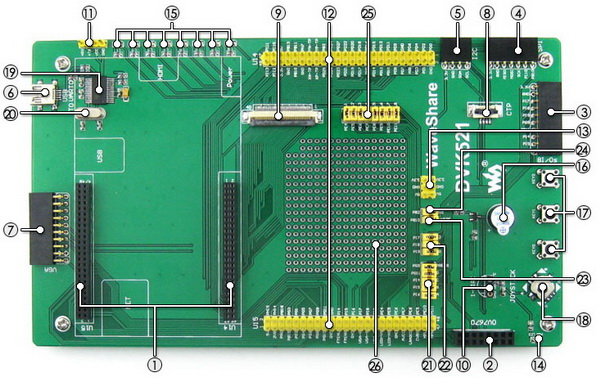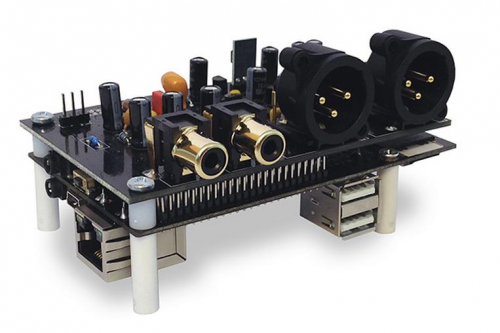User Tools
Sidebar
Table of Contents
Expander Boards
DVK521
About
DVK521 is an expansion board designed for Cubieboard by Waveshare Electronics(a Chinese company), integrates various components and interfaces for connecting external accessory boards. It's ideal for Cubieboard evaluation and development.
Specs:
1. Cubieboard socket 2. OV7670 interface: for connecting OV7670 Camera Module 3. 8I/Os interface: easily connects to modules controlled by I/Os, such as 8 Push Buttons 4. SPI interface: easily connects to SPI modules such as AT45DBXX Dataflash, etc. 5. I2C interface: easily connects to I2C modules such as PCF8574 Expansion Module, PCF8563 RTC Module, etc. 6. USB interface: USB TO UART, convenient for debugging 7. VGA interface: for connecting VGA display Module 8. Capacitive touch screen socket: for connecting capacitive touch screen using I2C interface 9. 7inch LCD interface: for connecting 7inch LCD 10.ONE-WIRE interface: easily connects to ONE-WIRE devices (TO-92 package), such as temperature sensor (DS18B20), electronic registration number (DS2401), etc. 11.UART interface (PL2303TA): connects to the UART interface of Cubieboard 12.Cubieboard Ext Ports 13.5V/3.3 V power input/output: usually used as power output, also common-grounding with other user board 14.Power indicator 15.User LEDs 16.Buzzer 17.User Keys 18.Joystick: five positions 19.PL2303TA: onboard USB TO UART convertor 20.12M crystal: for PL2303TA 21.Joystick jumper 22.User Keysjumper 23.ONE-WIRE jumper 24.Buzzer jumper 25.User LEDs jumper 26.Prototyping area: can be used to place user components for experiments
For jumpers above:
。short the jumper to connect to I/Os used in example code 。open the jumper to connect to other custom pins via jumper wires
Cubie Baseboard
About
George Ioakimedes of IO Technologies, LLC (a USA based company) is announcing the availability of their Baseboard for Cubieboard. This is a very important addition to the Cubieboard community.
As George explains it. “A Baseboard is a developer board and, like the Cubieboard, is very extensible and can connect to a variety of devices including sensors. To simplify the connection to additional devices, it is common to have an additional printed circuit called daughterboard or baseboard. This board is a baseboard, because it acts as a base to the Cubieboard. The Cubieboard can take power from this baseboard.”
Specs:
- 2mm pitch female sockets to accept Cubieboard
- All 96 Cubie pins brought out to 0.100" pitch headers
- LVDS header w/ separate LCD Backlight connector to match low cost LVDS cable
- 4-wire touch screen connector
- Standard 2.1mm DC jack, 12V-18V input
- Onboard 5.0V switching regulator to power Cubie and provide 3A (available on 0.100" header)
- Onboard 3.3V switching regulator to power LCD and provide 3A (available on 0.100" header)
- 15W Stereo Class D Audio Amplifier
- VGA circuit and HD15 connector
- 10cm x 10cm
Links
CubieNOS
About
CubieNOS is what it sounds like. It’s a Non Oversampling (NOS) Dac. It’s designed by HIFI enthusiasts for enthusiasts and DIY people.
“Our main focus is on best possible and natural sound and not numbers like total harmonic distortion.” – George at G2 labs
The idea is simple. Low number of components with a well thought out PCB design for shortest signal path possible. Early balanced stage in the digital signal path and fully balanced the whole way through with dual Philips D/A converters and a Burr Brown buffered output stage with enough power to drive low impedance headphones. And of course, no capacitors in signal path.
CubieNOS is produced in two different versions, either in a NOS configuration or with a fixed output with a frequency at 176.4 kHz.
Output:
- L/R Balanced XLR
- L/R Unbalanced RCA
- L/R Unbalanced headphones 2.54mm pin (header CON_1)
- Alphanumeric displayport 2.54mm pin (header CON_2)



